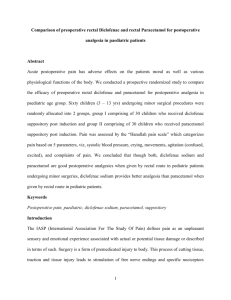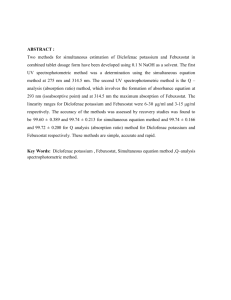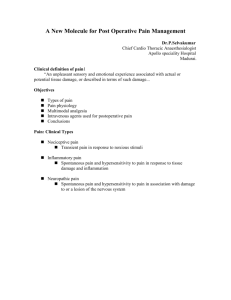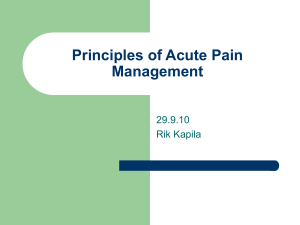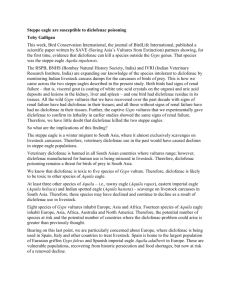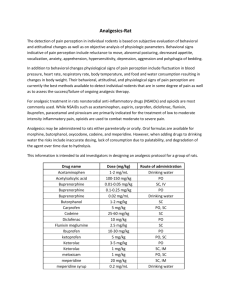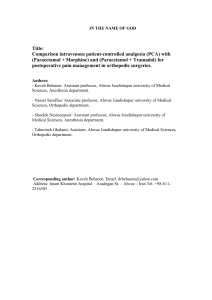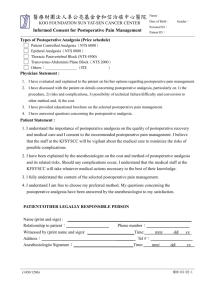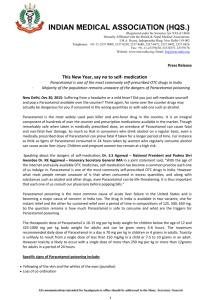between Diclofenac and Paracetamol groups
advertisement
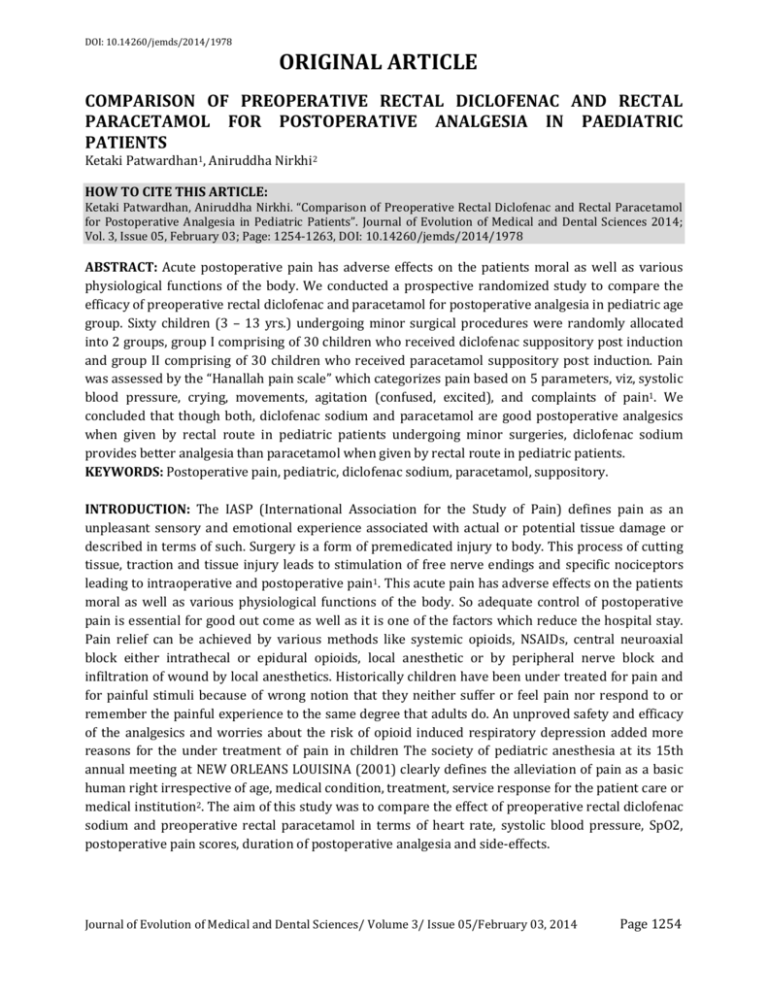
DOI: 10.14260/jemds/2014/1978 ORIGINAL ARTICLE COMPARISON OF PREOPERATIVE RECTAL DICLOFENAC AND RECTAL PARACETAMOL FOR POSTOPERATIVE ANALGESIA IN PAEDIATRIC PATIENTS Ketaki Patwardhan1, Aniruddha Nirkhi2 HOW TO CITE THIS ARTICLE: Ketaki Patwardhan, Aniruddha Nirkhi. “Comparison of Preoperative Rectal Diclofenac and Rectal Paracetamol for Postoperative Analgesia in Pediatric Patients”. Journal of Evolution of Medical and Dental Sciences 2014; Vol. 3, Issue 05, February 03; Page: 1254-1263, DOI: 10.14260/jemds/2014/1978 ABSTRACT: Acute postoperative pain has adverse effects on the patients moral as well as various physiological functions of the body. We conducted a prospective randomized study to compare the efficacy of preoperative rectal diclofenac and paracetamol for postoperative analgesia in pediatric age group. Sixty children (3 – 13 yrs.) undergoing minor surgical procedures were randomly allocated into 2 groups, group I comprising of 30 children who received diclofenac suppository post induction and group II comprising of 30 children who received paracetamol suppository post induction. Pain was assessed by the “Hanallah pain scale” which categorizes pain based on 5 parameters, viz, systolic blood pressure, crying, movements, agitation (confused, excited), and complaints of pain1. We concluded that though both, diclofenac sodium and paracetamol are good postoperative analgesics when given by rectal route in pediatric patients undergoing minor surgeries, diclofenac sodium provides better analgesia than paracetamol when given by rectal route in pediatric patients. KEYWORDS: Postoperative pain, pediatric, diclofenac sodium, paracetamol, suppository. INTRODUCTION: The IASP (International Association for the Study of Pain) defines pain as an unpleasant sensory and emotional experience associated with actual or potential tissue damage or described in terms of such. Surgery is a form of premedicated injury to body. This process of cutting tissue, traction and tissue injury leads to stimulation of free nerve endings and specific nociceptors leading to intraoperative and postoperative pain1. This acute pain has adverse effects on the patients moral as well as various physiological functions of the body. So adequate control of postoperative pain is essential for good out come as well as it is one of the factors which reduce the hospital stay. Pain relief can be achieved by various methods like systemic opioids, NSAIDs, central neuroaxial block either intrathecal or epidural opioids, local anesthetic or by peripheral nerve block and infiltration of wound by local anesthetics. Historically children have been under treated for pain and for painful stimuli because of wrong notion that they neither suffer or feel pain nor respond to or remember the painful experience to the same degree that adults do. An unproved safety and efficacy of the analgesics and worries about the risk of opioid induced respiratory depression added more reasons for the under treatment of pain in children The society of pediatric anesthesia at its 15th annual meeting at NEW ORLEANS LOUISINA (2001) clearly defines the alleviation of pain as a basic human right irrespective of age, medical condition, treatment, service response for the patient care or medical institution2. The aim of this study was to compare the effect of preoperative rectal diclofenac sodium and preoperative rectal paracetamol in terms of heart rate, systolic blood pressure, SpO2, postoperative pain scores, duration of postoperative analgesia and side-effects. Journal of Evolution of Medical and Dental Sciences/ Volume 3/ Issue 05/February 03, 2014 Page 1254 DOI: 10.14260/jemds/2014/1978 ORIGINAL ARTICLE METHODS: In this study, 60 patients of either sex, age between 3 – 13 years, belonging to ASA grades I, II undergoing short surgical procedures were studied. Following patients were excluded from this study: 1. ASA grade III, IV or V 2. Patients with congenital heart disease 3. Patients scheduled for neurosurgery 4. Duration of surgery>180 min 5. Patients with anal/rectal pathology 6. Patients with known renal disease These patients were randomly allocated to two groups: Group I – comprised of patients who received diclofenac suppository immediately following induction. Group II – comprised of patients who received paracetamol suppository immediately following induction. Preoperative written informed consent was taken from parent/guardian. Patients were kept NBM for 6 hrs. preoperatively. In the operating room, monitors, viz, pulse oximeter, blood pressure cuff and ECG monitor were attached. An IV line was taken on left arm with 22G/20G intracath with bivalve and a Ringer Lactate solution started. All patients were premedicated with Inj.Glycopyrrolate 0.004mg/kg, Inj.Ranitidine 1 mg/kg, Inj.Midazolam 0.03mg/kg, Inj.Ondansetron 0.08 mg/kg. Patients in both groups were preoxygenated with 100% O2. Induction was done with Inj.propofol 2mg/kg, with loss of eyelash reflex as the anesthetic endpoint. After confirming that patient could be ventilated on mask, skeletal muscle relaxation was obtained with Inj.Vecuronium 0.08mg/kg. Patients were ventilated with reservoir bag and mask for 4 min. Endotracheal intubation was done with proper sized uncuffed armoured portex endotracheal tube. Air entry was checked on both sides of chest by auscultation, and tube fixed by adhesive tape. Patients in group I received Diclofenac suppository 1.5-3mg/kg post induction. Patients in group II received Paracetamol suppository 15-30mg/kg post induction. Patients were maintained on O2+N2O with Inj.vecuronium with controlled on J-R circuit/Baines circuit. Vital parameters, viz, Heart rate, systolic blood pressure and SpO2 were monitored every 30 min intraoperatively and their mean values found out. Patients were extubated after reversal of neuromuscular blockade. Pain was assessed by the “Hanallah pain scale2”. This is a pain scale which categorizes pain based on 5 parameters, viz, - systolic blood pressure - crying - movements - agitation(confused, excited) - complains of pain Journal of Evolution of Medical and Dental Sciences/ Volume 3/ Issue 05/February 03, 2014 Page 1255 DOI: 10.14260/jemds/2014/1978 ORIGINAL ARTICLE At 0 hrs. after extubation, heart rate, systolic blood pressure, SpO2 and Hanallah Pain Scale were recorded. These parameters were also observed at 1, 2 and 6 hrs. after surgery in the recovery room and ward. Rescue analgesic was given routinely after 6 hrs. postoperatively or when HPS score was>5 in the form of Inj.diclofenac IV 1mg/kg. All patients were observed for any side-effects in the postoperative period for 6 hrs.in the ward, and any complication if occurred was treated in the conventional manner. The data thus obtained was statistically analyzed. The P value of >0.05 was considered as statistically significant. RESULTS: We found that rectal Diclofenac and Paracetamol, both possess analgesic action, but the postoperative pain scores in patients who received rectal Diclofenac are better as compared to those in the paracetamol group, the difference between the pain scales being statistically significant (p<0.05).We also found that though the difference in mean heart rate and systolic blood pressure at various events in both the groups is not statistically significant, diclofenac shows greater stability with respect to effect on heart rate, especially postoperatively. Incidence of nausea was more with diclofenac suppository, though not statistically significant. DISCUSSION: Relief of pain is one of the greatest objectives of medicine and providing relief from pain has been one of the achievements of medicine. Under treatment of postoperative pain in children may trigger biochemical and physiologic stress response and cause impairment in pulmonary, cardiovascular, neuroendocrinal, gastrointestinal, immunological, and metabolic function3. We conducted a prospective, randomized study to compare the efficacy of preoperative rectal diclofenac and rectal paracetamol for postoperative analgesia in pediatric age group was conducted in a public Hospital. We found that rectal Diclofenac and Paracetamol both possess analgesic action, but the postoperative pain scores in patients who received rectal Diclofenac are better as compared to those in the paracetamol group. Journal of Evolution of Medical and Dental Sciences/ Volume 3/ Issue 05/February 03, 2014 Page 1256 DOI: 10.14260/jemds/2014/1978 ORIGINAL ARTICLE These findings were consistent with the findings of Baer GA, Rorarius MG, Kolehmainen S, Selin S. in Dec 19924 who compared the effects of rectally administered diclofenac (12.5 mg) with paracetamol (125 mg) on pre- and postoperative behavior and the need for supplementary analgesia in 44 children scheduled for adenoidectomy (with or without myringotomy). The children who had received diclofenac were significantly quieter (< 0.05), easier to handle (p < 0.01) and cried less (p < 0.05) than those in the paracetamol group. During recovery, children in the diclofenac group needed fewer supplementary doses of intravenous pethidine than those receiving paracetamol (p < 0.001). Similarly, O'Donnell A, Henderson M in March 20075 studied management of postoperative pain in children following extractions of primary teeth under general anesthesia: a comparison of paracetamol, Voltarol and no analgesia. Children reported significantly less pain when rectal Voltarol was provided prior to the extractions, as compared to paracetamol or no analgesia. The greatest amount of pain was reported by the group who had received no analgesia. Jyoti Borkar, Nandini Dave in 20026 studied the analgesic Efficacy of Caudal Block versus Diclofenac Suppository and Local Anesthetic Infiltration Following Pediatric Laparoscopy. They studied 50 children undergoing laparoscopy for diagnostic and therapeutic purposes. Their ages ranged from 3 to 13 years, and all belonged to American Society of Anesthesiologists (ASA) class I or II. Anesthesia was carried out using the standard procedure. Patients were randomly assigned to one of two groups. Group 1 received caudal block with bupivacaine 1 ml/kg after anesthetic induction. Group 2 received diclofenac suppository 3 mg/kg post induction and local anesthetic infiltration at the port sites at the end of the procedure. Pain was assessed using the Hannallah objective pain scale at 15, 30, 60, 120, and 360 minutes post extubation. The pain scores were comparable in both groups at all times. They found the analgesic efficacy of diclofenac suppository combined with local anesthetic infiltration at port sites comparable to caudal block. The same pain scale was used in our study. We observed that though the difference in mean heart rate at various events in both the groups was not statistically significant, diclofenac showed greater stability with respect to effect on heart rate, especially postoperatively. Leont'ev DV, BabaevBD, et al In 20057 conducted a study to comparatively assess the adequacy of postoperative analgesia using nonsteroidal anti-inflammatory drugs (NSAIDs) and paracetamol in children undergone "minor" surgical interventions. The efficiency of postoperative analgesia was evaluated, by using central hemodynamic parameters that many investigators consider to be one of the major criteria for the adequacy of anesthesia. Comparative analysis of the efficiency of postoperative analgesia of the above agents has indicated that diclofenac and paracetamol have a sufficient analgesic activity and at the same time do not show the adverse reactions unique to narcotic analgesics. The incidence of nausea was 23.30% in diclofenac group, while 76.70% had no side effects, In the paracetamol group, the incidence of nausea was 10.00%, while 90.00% had no side effects. Pluim MA, Wegener JT, et alin19998 compared tramadol suppositories and rectal acetaminophen/codeine for postoperative pain relief. There was no difference in pain scores between the two groups. The incidence of nausea and vomiting was significantly higher in the tramadol-treated (84%) than in the acetaminophen/codeine treated group (31%). The relative risk of experiencing an episode of nausea under treatment with tramadol was 2.7 (95% confidence interval: 1.3-5.3; P = 0.0001) as compared with acetaminophen/codeine. Journal of Evolution of Medical and Dental Sciences/ Volume 3/ Issue 05/February 03, 2014 Page 1257 DOI: 10.14260/jemds/2014/1978 ORIGINAL ARTICLE In our study, there were no complications such as increased intraoperative hemorrhage or increased postoperative blood loss, in either group. Baer GA, Rorarius MG, Kolehmainen S, Selin S. in Dec 199225compared the effects of rectally administered diclofenac (12.5 mg) with paracetamol (125 mg) on pre- and postoperative behavior and the need for supplementary analgesia in 44 children scheduled for adenoidectomy (with or without myringotomy). There were no obvious differences between the groups in intra-operative bleeding (as estimated by the surgeon), or in measured blood loss. No postoperative complications became evident. CONCLUSION: We concluded that rectal diclofenac sodium and paracetamol are good postoperative analgesics in pediatric patients undergoing minor surgeries. Diclofenac sodium provides better analgesia. Haemodynamic stability is better with diclofenac sodium suppository. REFERENCES: 1. Morgan’s clinical anesthesiology, fourth edition, page 939 2. Meena Doda and Sambrita Mukherje. Postoperative Analgesia in Children- Comparative Study between Caudal Bupivacaine and Bupivacaine plus Tramadol. Indian J Anaesth; 53(4) 463466 3. Robert W, Hurley, Christopher I. Wu. Acute postoperative pain, Miller’s Anesthesia, page 2775-2776. 4. Baer GA, Rorarius MG, Kolehmainen S, Selin S. The effect of paracetamol or diclofenac administered before operation on postoperative pain and behaviour after adenoidectomy in small children. Anaesthesia. 1992 Dec; 47(12):1078-80. 5. O'Donnell A, Henderson M et al. Management of postoperative pain in children following extractions of primary teeth under general anaesthesia: a comparison of paracetamolVoltarol and no analgesia. Int J Paediatr Dent. 2007 Mar; 17(2):110-5. 6. Jyoti Borkar, Nandini Dave. Analgesic Efficacy of Caudal Block Versus Diclofenac Suppository and Local Anesthetic Infiltration Following Pediatric Laparoscopy. Journal of Laparoendoscopic & Advanced Surgical Techniques. 2005, 15(4): 415-418. 7. Leont'ev DV, BabaevBD, et al. Effect of nonsteroidal anti-inflammatory drugs and paracetamol on hemodynamic changes during postoperative analgesia in children. Anesteziol Reanimatol. 2005 Jan-Feb ;( 1):22-5. 8. Pluim MA, Wegener JT, et al. Tramadol suppositories are less suitable for post-operative pain relief than rectal acetaminophen/codeine. Eur J Anaesthesiol. 1999 Jul; 16(7):473-8. Journal of Evolution of Medical and Dental Sciences/ Volume 3/ Issue 05/February 03, 2014 Page 1258 DOI: 10.14260/jemds/2014/1978 ORIGINAL ARTICLE OBSERVATIONS AND RESULTS: SEX DICLOFENAC GROUP PARACETAMOL GROUP M 19 16 F 11 14 MEAN AGE (yrs.) 7.93 6.68 MEAN WEIGHT (kg) 18.63 15.93 MEAN DURATION OF SURGERY(min) 87.50 78.50 Demographic characteristics of Diclofenac and Paracetamol groups There was no bias as regards the demographical characteristics. Type of surgery Gen. Surgery Ortho surgery ENT surgery Total Diclofenac group 18 06 06 30 Paracetamol group 20 04 06 30 Total 38 10 12 60 Comparison between diclofenac and paracetamol groups regarding the type of surgery There was no bias as regards the type of surgery in both the groups. Side effects observed among Diclofenac and Paracetamol groups The incidence of nausea was comparatively higher in diclofenac group than paracetamol group but the difference was not statistically significant. Journal of Evolution of Medical and Dental Sciences/ Volume 3/ Issue 05/February 03, 2014 Page 1259 DOI: 10.14260/jemds/2014/1978 ORIGINAL ARTICLE Comparison of time to rescue analgesic among Diclofenac and Paracetamol groups There was no statistically significant difference in both the groups as regards the time to rescue analgesic. Comparison of Heart Rate at various time intervals between Diclofenac and Paracetamol groups Though the difference in mean heart rate at various events in both the groups is not statistically significant, diclofenac shows greater stability with respect to effect on heart rate, especially postoperatively. Journal of Evolution of Medical and Dental Sciences/ Volume 3/ Issue 05/February 03, 2014 Page 1260 DOI: 10.14260/jemds/2014/1978 ORIGINAL ARTICLE Comparison of Systolic Blood Pressure at various time intervals between Diclofenac and Paracetamol groups Though the difference in mean systolic blood pressure at various events in both the groups is not statistically significant, diclofenac shows greater stability with respect to effect on systolic blood pressure, especially postoperatively. Comparison of SpO2 at various time intervals between Diclofenac and Paracetamol groups There was no statistically significant difference in both the groups as regards the SpO2. Journal of Evolution of Medical and Dental Sciences/ Volume 3/ Issue 05/February 03, 2014 Page 1261 DOI: 10.14260/jemds/2014/1978 ORIGINAL ARTICLE Comparison of HPS (Hanallah Pain Scale) at various time intervals between Diclofenac and Paracetamol groups Diclofenac and Paracetamol, both possess analgesic action, but the postoperative pain scores in patients who received rectal Diclofenac are better as compared to those in the paracetamol group, the difference between the pain scales being statistically significant (p<0.05). Comparison of HPS at various time intervals with its pre-operative level in Diclofenac group Journal of Evolution of Medical and Dental Sciences/ Volume 3/ Issue 05/February 03, 2014 Page 1262 DOI: 10.14260/jemds/2014/1978 ORIGINAL ARTICLE Comparison of HPS at various time intervals with its pre-operative level in Paracetamol group AUTHORS: 1. Ketaki Patwardhan 2. Aniruddha Nirkhi PARTICULARS OF CONTRIBUTORS: 1. Assistant Professor, Department of Anaesthesia, J.J. Hospital, Mumbai. 2. Consultant Cardiac Anaesthetist, Department of Anaesthesia, Bombay Hospital, Mumbai. NAME ADDRESS EMAIL ID OF THE CORRESPONDING AUTHOR: Dr. Ketaki Patwardhan, Flat No. 2, Building No. 4, J.J. Hospital Building, Mumbai, India. E-mail: ketaki_p18@yahoo.co.in Date of Submission: 05/01/2014. Date of Peer Review: 06/01/2014. Date of Acceptance: 23/01/2014. Date of Publishing: 30/01/2014. Journal of Evolution of Medical and Dental Sciences/ Volume 3/ Issue 05/February 03, 2014 Page 1263
